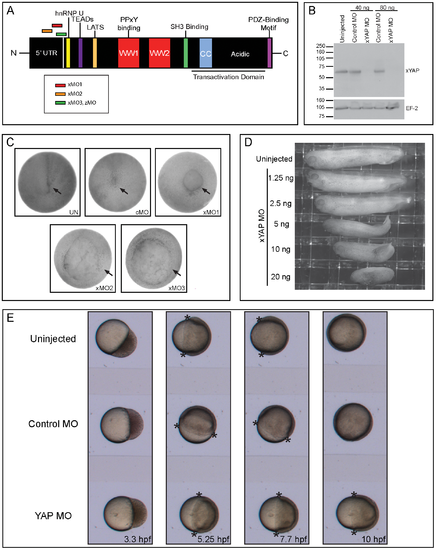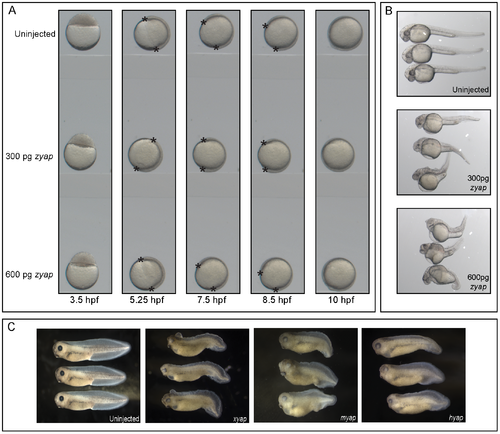- Title
-
Yes-associated protein 65 (YAP) expands neural progenitors and regulates Pax3 expression in the neural plate border zone.
- Authors
- Gee, S.T., Milgram, S.L., Kramer, K.L., Conlon, F.L., Moody, S.A.
- Source
- Full text @ PLoS One
|
YAP morphant embryos exhibit defects in A-P axis elongation. (A) Frog and zebrafish YAP possess the ascribed functional and protein-protein interaction domains, including the TEAD-binding site (purple), the LATS phosphorylation site (orange), the two WW domains (red) that allow for PPxY binding, the Src Homology 3 (SH3)-binding domain (green), the coiled-coil region (blue), the transactivation domain (underline), and the PDZ-binding motif (pink). hnRNP U (yellow) binding has only been experimentally tested with human YAP, but related sites are in the fish and frog proteins. This diagram also illustrates the relative location of Xenopus laevis (x) and Danio rerio (z) MO-binding sites. (B) Injection of an equimolar cocktail of all three xYAP MOs at two concentrations (40 ng and 80 ng) resulted in efficient knockdown of endogenous, zygotic xYAP protein in stage 15 embryos as measured by western blot analysis. EF-2 expression from the same blot served as the loading control. (C) Three different xYAP MOs (80 ng; see A for binding sites) resulted in failed closure of the blastopore (arrows). (D) Reducing the concentration of the xYAP MO cocktail (left side) allowed blastopore closure, but resulted in dose-dependent A-P axis shortening. (E) Time-lapse video microscopy showed that zYAP MO (16 ng) injected embryos also exhibit perturbation in the completion of gastrulation. Asterisks mark the tissue front of epiboly movements. In uninjected and cMO-injected embryos, this front completely envelops the yolk by 10 hours post-fertilization (hpf). These fronts are still in the equatorial region in the 7.7–10 hpf YAP MO-injected embryos. |
|
zYAP and xYAP gain-of-function results in similar body axis defects. (A) Time-lapse videomicroscopy shows that zYAP gain-of-function does not alter the timing of gastrulation movements, as evidenced by the progression of epiboly (asterisks mark the fronts of tissue movement around the yolk). (B) zYAP gain-of-function in Danio rerio embryos resulted in head and eye deformities and shortened, malformed body axes. Examples of two different mRNA doses are shown. (C) Injection of Xenopus (x), mouse (m), or human (h) yap mRNAs into Xenopus embryos all showed phenotypes similar to those in zebrafish. |


